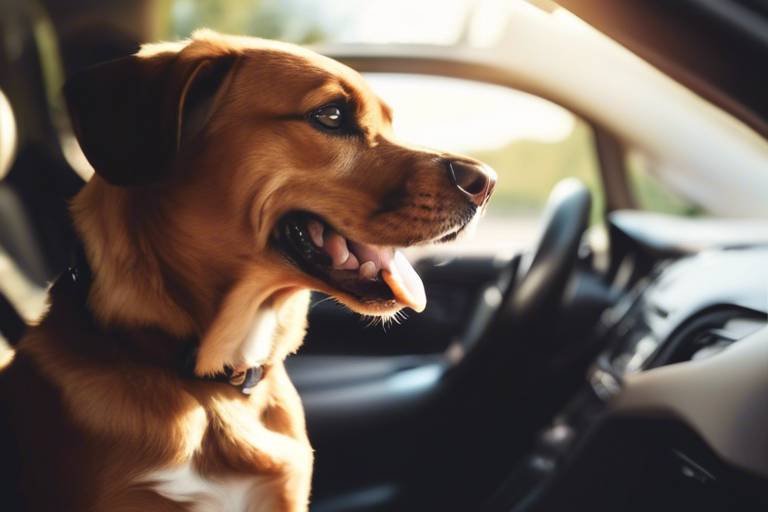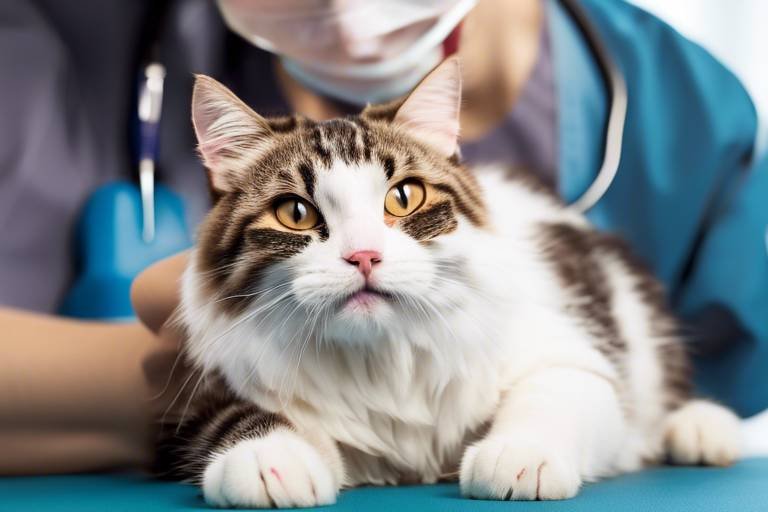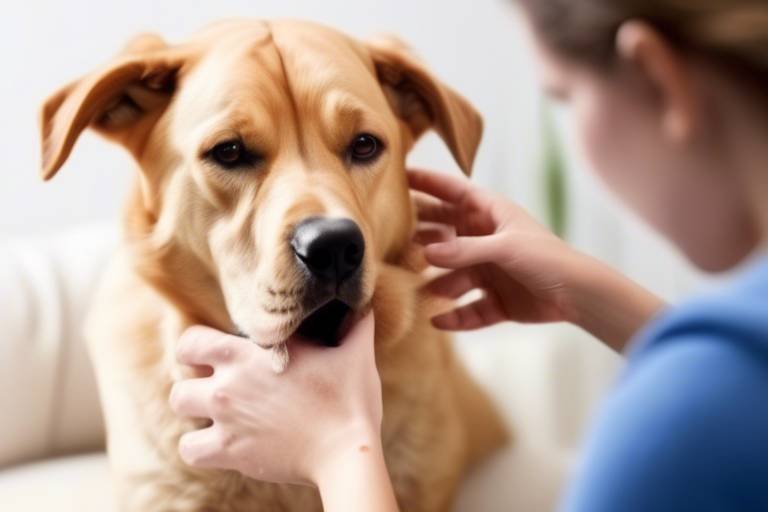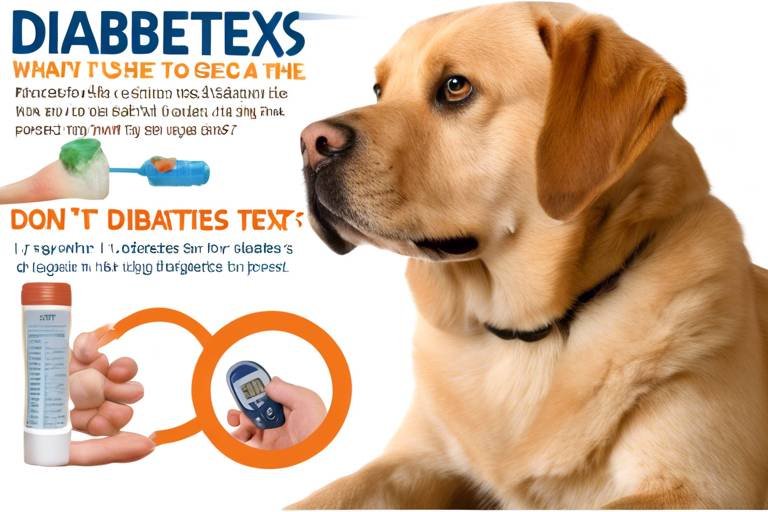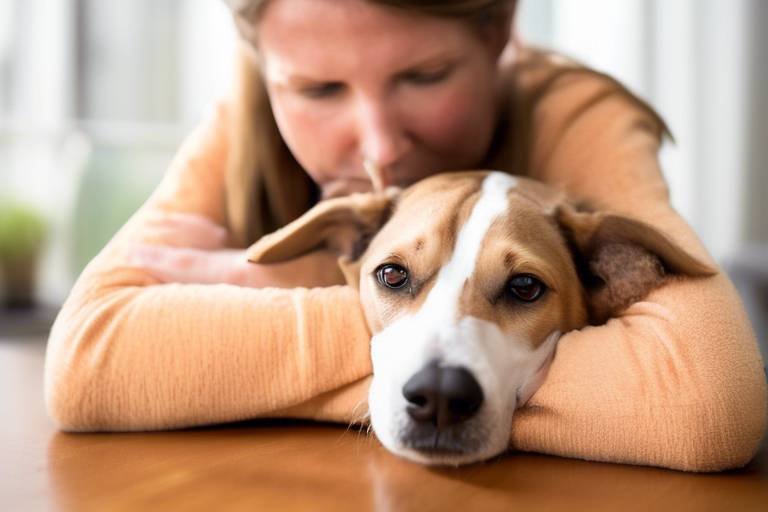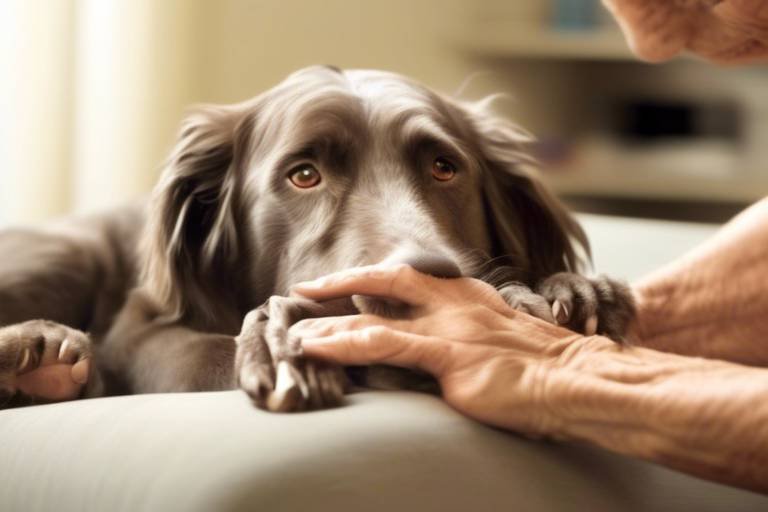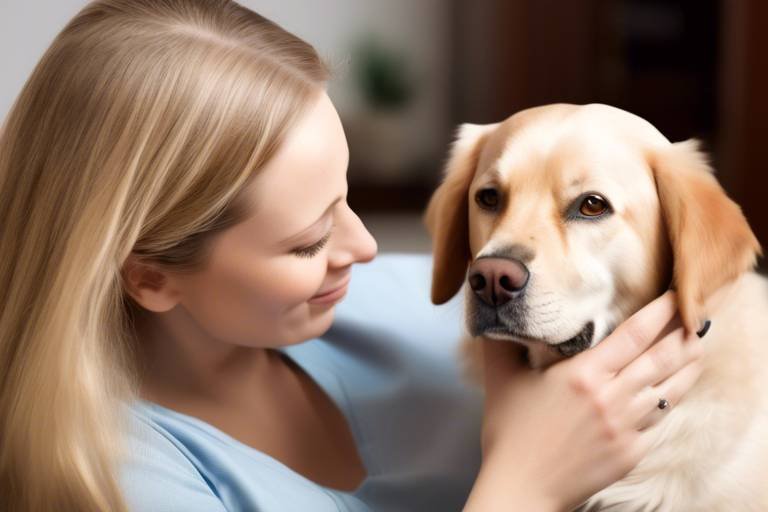How to Safely Travel with Pets in the Car
Traveling with your furry companions can be one of the most rewarding experiences, but it also comes with its own set of challenges. Imagine the joy of hitting the open road with your pet by your side, their ears flapping in the wind, and their tail wagging in excitement. However, ensuring a safe and enjoyable journey requires some careful planning and preparation. This article provides essential tips and guidelines for pet owners to ensure a safe and enjoyable car journey with their furry companions. From preparing your pet for travel to managing their comfort during the ride, we’ll cover everything you need to know to keep your pet happy and secure on the road.
Before you even think about starting the car, it's crucial to prepare your pet for the journey. This means acclimating them to the car environment. If your pet is not used to traveling, consider taking them on short drives around the neighborhood to help them get comfortable. Make sure to bring along their favorite blanket or toy to create a sense of familiarity. A positive association with the car can make a world of difference. Remember, the goal is to make your pet feel safe and relaxed, so take your time and be patient during this acclimation process.
Investing in the right travel gear can significantly enhance your pet's safety and comfort. Think of it as packing a little suitcase for your furry friend! Here are some must-have items for a smooth car ride:
- Pet Safety Restraints: Using appropriate safety restraints is vital for your pet's protection. Harnesses and carriers can keep your pet secure during travel.
- Water and Food Bowls: Always have collapsible bowls on hand for hydration and snacks during breaks.
- First Aid Kit: A pet-specific first aid kit can be a lifesaver in case of emergencies.
Using appropriate safety restraints is not just a good idea; it's a necessity. Think of your pet as a little passenger who needs their own seatbelt. Harnesses designed for pets can keep them secure and prevent them from roaming around the car, which can be distracting and dangerous. There are various types of restraints available, including seatbelt attachments, carriers, and specialized pet seat covers. Each option has its benefits, so consider your pet's size, temperament, and your car's layout when making a choice.
Selecting the right carrier for your pet can make a significant difference in their travel experience. A good carrier should be well-ventilated, spacious enough for your pet to stand up and turn around, and easy to secure in your vehicle. Consider your pet's personality; some pets feel secure in enclosed spaces, while others may prefer a more open environment. Always ensure that the carrier is labeled with your contact information, just in case you get separated during your travels.
Seat belts designed for pets offer an extra layer of safety. They work just like human seat belts but are tailored for your furry friend. To use them properly, attach the harness to your pet, then clip the seatbelt attachment into your car’s seatbelt buckle. This way, your pet can enjoy the ride without the risk of injury in case of sudden stops or accidents. It’s a simple step that can provide peace of mind for you and safety for your pet.
Prior to travel, it’s essential to consider your pet's health needs. Make sure their vaccinations are up to date and consult your veterinarian about any medications they may need during the trip. If your pet has a history of anxiety or motion sickness, discuss potential solutions with your vet. It’s also a good idea to carry a copy of their medical records, just in case you need to visit a vet while on the road. Remember, a little preparation goes a long way in ensuring a smooth journey.
Keeping your pet comfortable during the journey is essential. A happy pet makes for a happy trip! One of the most important aspects of comfort is temperature control. Make sure your car is at a comfortable temperature for your pet. On hot days, never leave your pet in a parked car, even for a minute, as temperatures can rise quickly. Use air conditioning or open windows to keep them cool. Conversely, if it’s cold, ensure they have a cozy blanket to snuggle up with.
Maintaining a comfortable temperature in the car is crucial for your pet's well-being. Always check the weather before departing and adjust the car’s climate accordingly. If it’s too hot, consider taking breaks in shaded areas or using a pet cooling vest. If it’s chilly, a pet-friendly blanket can help keep them warm. You wouldn’t want to be stuck in a sauna or freezer, so think about your pet's comfort!
Regular breaks during long trips allow your pet to stretch and relieve themselves. Plan to stop every couple of hours for a quick potty break and a little exercise. This not only helps keep your pet comfortable but also prevents restlessness and boredom. During breaks, let your pet walk around on a leash, and engage them in a game of fetch or tug-of-war. Trust me, a little playtime can do wonders for their mood!
Some pets may experience motion sickness during travel. It’s a common issue, but it can be managed with a few strategies. If your pet seems anxious or uncomfortable during car rides, take note of their behavior. Recognizing the signs of motion sickness early can help you intervene promptly and keep your pet comfortable.
Recognizing the signs of motion sickness in pets is important for timely intervention. Symptoms may include drooling, whining, excessive panting, or vomiting. If you notice any of these signs, it’s best to pull over safely and give your pet a break. A little fresh air can work wonders!
Implementing preventative measures can help reduce the likelihood of motion sickness. Try feeding your pet a light meal a few hours before the trip, and avoid heavy meals that can upset their stomach. You might also consider training your pet to get used to the car gradually or consulting your vet about medication options. Remember, every pet is different, so what works for one might not work for another.
Understanding legal requirements for traveling with pets is vital for a hassle-free experience. Different states have varying regulations regarding pet travel, so familiarize yourself with the specific laws in each state to avoid potential issues during your journey. This can include leash laws, breed restrictions, and regulations about pet travel in public transportation.
Before you hit the road, take a moment to research pet travel regulations by state. Some states may require specific vaccinations or health certificates, especially if you're crossing state lines. Check for any breed-specific laws that may apply to your pet, as some areas have restrictions on certain breeds. A little research can save you a lot of trouble down the road!
Ensuring your pet is properly identified is crucial for their safety. Always have a collar with an ID tag that includes your contact information. Microchipping is also a fantastic option for added security. In case your pet gets lost, a microchip can help reunite you with your furry friend quickly. It’s a small step that can make a huge difference in an emergency.
Q: Can I leave my pet in the car while I run errands?
A: No, it’s unsafe to leave your pet in a parked car, especially on hot days. Temperatures can rise quickly, leading to heatstroke.
Q: How can I prevent my pet from getting anxious during travel?
A: Gradually acclimate your pet to the car, use calming products, and take regular breaks to keep them relaxed.
Q: What should I do if my pet gets sick during the journey?
A: Pull over safely, give your pet fresh air, and clean up any messes. If symptoms persist, consult your veterinarian.

Preparing Your Pet for Travel
Before you embark on your adventure, it's essential to prepare your pet for the journey ahead. Think of this as packing your bags for a vacation; you wouldn't leave home without the essentials, right? Similarly, your furry friend needs to be ready too! Start by allowing your pet to acclimate to the car. This can be done by taking short trips around the neighborhood. Not only will this help them get used to the car's movement, but it will also make them feel more comfortable when it's time for a longer ride.
Next, consider your pet's comfort level. If your dog or cat is not accustomed to being in a vehicle, they may feel anxious. To ease their nerves, bring along their favorite blanket or toy. Familiar scents can be incredibly soothing. Additionally, it’s a good idea to take your pet for a walk before the journey. This way, they can expend some energy and feel more relaxed during the ride.
Another crucial aspect of preparation is to check your pet's health. Ensure that vaccinations are up to date and that your pet is in good health for travel. If your pet has a history of travel anxiety or motion sickness, consult your veterinarian beforehand. They might recommend medications or supplements to help your pet feel more at ease. Remember, a little bit of preparation goes a long way toward ensuring a smooth and enjoyable trip for both you and your furry companion!
Lastly, always have a travel kit ready. This kit should include essentials such as:
- Food and water
- Collapsible bowls
- Leash and harness
- Waste bags
- First-aid supplies
By preparing adequately, you can ensure that your pet is not only safe but also comfortable during your travels. So, grab those supplies, buckle up, and get ready for an adventure with your beloved pet!

Essential Travel Gear for Pets
When it comes to hitting the road with your furry friend, having the right travel gear can make all the difference. Imagine embarking on a journey where your pet feels secure, comfortable, and happy throughout the ride. Sounds ideal, right? To achieve this, you need to invest in some essential travel gear that not only ensures their safety but also enhances their overall experience.
First and foremost, pet safety restraints are a must-have. Just like we buckle up for safety, our pets deserve the same protection. There are various options available, including harnesses and carriers designed specifically for car travel. A well-fitted harness can keep your pet securely in place, while a sturdy carrier can provide them with a cozy space to relax. But how do you choose the right one? Let’s break it down:
| Type of Restraint | Pros | Cons |
|---|---|---|
| Pet Harness | Allows freedom of movement; can be used outside the car. | May not be suitable for all pet sizes; requires proper fitting. |
| Pet Carrier | Provides a secure and familiar space; great for anxious pets. | Can take up space in the car; may be heavy to carry. |
| Seat Belt for Pets | Easy to use; keeps pets in one place. | Some pets may resist wearing it; requires proper adjustment. |
Next, choosing the right carrier is crucial. Think of it as your pet's little home on wheels. When selecting a carrier, consider the size and temperament of your pet. A carrier that is too small can lead to discomfort, while one that is too large may not provide the sense of security they need. Look for carriers with good ventilation and easy access. Some even come with added features like pockets for treats or toys!
Now, let’s talk about using seat belts for pets. Just like we buckle up our kids, pets need that extra layer of safety. Pet seat belts are designed to attach to your pet’s harness and clip into the car’s seat belt system. This keeps them secure and prevents them from roaming around the vehicle, which can be a distraction while driving. Make sure to adjust the seat belt properly so your pet has enough room to sit or lie down comfortably without compromising their safety.
Besides restraints, consider packing some essential travel items to keep your pet happy on the road. Here’s a quick checklist:
- Water and a portable bowl
- Favorite toys and blankets
- Food and treats
- Leash and waste bags
- First aid kit for pets
Having these items on hand can help you address your pet's needs during the journey, making it a more enjoyable experience for both of you. Remember, a little preparation goes a long way in ensuring a smooth ride with your beloved pet!
Q: Can I let my pet roam freely in the car?
A: It's not safe to let your pet roam freely in the car as it can be a distraction and increases the risk of injury during sudden stops.
Q: What should I do if my pet gets anxious during travel?
A: Consider using calming products such as anxiety wraps or consult your veterinarian about safe sedatives for travel.
Q: How often should I take breaks during long trips?
A: It's recommended to take breaks every 2-3 hours to allow your pet to stretch, relieve themselves, and stay hydrated.
Pet Safety Restraints
When it comes to traveling with your furry friend, are not just an option; they are a necessity. Imagine driving down the highway with your beloved dog or cat unrestrained, bouncing around the car like a pinball. Not only is this dangerous for your pet, but it can also distract you as the driver, leading to potential accidents. So, let’s dive into the world of pet safety restraints and explore how they can keep your pet secure and comfortable during your travels.
There are several types of restraints available, each designed to cater to different needs and preferences. The most common options include:
- Pet Seat Belts: These are similar to regular seat belts but are designed specifically for pets. They connect to your pet's harness and keep them safely in place while allowing them to sit or lie down comfortably.
- Pet Carriers: Ideal for smaller pets, carriers provide a secure space for your pet to travel. They come in various sizes and designs, ensuring your pet feels cozy and safe.
- Travel Harnesses: These harnesses can be attached to the car's seat belt system. They are designed to distribute force across your pet's body in case of sudden stops, reducing the risk of injury.
Choosing the right restraint is crucial for your pet's safety. Here are some factors to consider:
| Type of Restraint | Best For | Advantages |
|---|---|---|
| Pet Seat Belts | Medium to Large Dogs | Easy to use, allows movement |
| Pet Carriers | Small Dogs and Cats | Secure and cozy environment |
| Travel Harnesses | All Sizes | Safety during sudden stops |
Remember, just like you wouldn’t drive without your seat belt, your pet deserves the same level of protection. Not only does using a restraint keep your pet safe during the journey, but it also provides peace of mind for you as a pet owner. Before you embark on your adventure, take the time to train your pet to accept their restraint. This can be as simple as letting them explore the harness or carrier at home before the trip. The more familiar they are, the more comfortable they will feel.
In conclusion, investing in the right pet safety restraint is a small price to pay for your pet’s safety and your own peace of mind. Whether you choose a seat belt, carrier, or harness, ensure that it fits well and is appropriate for your pet’s size and behavior. After all, a safe pet is a happy pet, and a happy pet makes for a more enjoyable road trip!
Choosing the Right Carrier
When it comes to traveling with your furry friend, selecting the right carrier is not just a matter of convenience—it's a matter of safety and comfort. A good carrier can make your pet feel secure and help reduce their anxiety during travel. So, how do you choose the perfect one? Well, let’s break it down!
First and foremost, consider the size of your pet. If you have a small dog or a cat, a cozy carrier that allows them to stand up, turn around, and lie down comfortably is essential. For larger breeds, you'll want something spacious yet secure. Measure your pet's height and length to find a carrier that fits well. A carrier that’s too small can lead to discomfort, while one that’s too large may not offer the security your pet needs. Remember: a snug fit is often more comforting for pets.
Next, think about the material of the carrier. There are various options available, including hard-sided carriers, soft-sided carriers, and even travel crates. Hard-sided carriers are generally more durable and easier to clean, which can be a lifesaver during long trips. On the other hand, soft-sided carriers are lightweight and can be more comfortable for your pet, especially if they enjoy snuggling up. Additionally, ensure that the carrier has proper ventilation. Airflow is crucial to keep your pet cool and comfortable during travel.
Another important factor to consider is the carrier's design. Look for features that enhance usability, such as:
- Easy-to-open doors for quick access
- Secure latches to prevent escapes
- Removable and washable liners for hygiene
Don’t forget to check if the carrier is airline-approved if you plan on flying. Airlines have specific regulations regarding pet carriers, and adhering to these guidelines will save you from last-minute hassles. Before making a purchase, do your research and read reviews from other pet owners to find a carrier that has a good track record.
Finally, once you’ve chosen the right carrier, introduce it to your pet well before the trip. Let them explore it, sniff around, and even spend time inside it while at home. This way, the carrier becomes a familiar and safe space, making the actual travel experience much smoother for both of you. After all, a happy pet makes for a happy journey!
Q: How do I know if the carrier is the right size for my pet?
A: Measure your pet's height and length while they are standing. The carrier should allow them to stand, turn around, and lie down comfortably.
Q: Can I use a regular backpack or bag as a pet carrier?
A: While it might be tempting, regular bags often lack the necessary ventilation and safety features. It's best to invest in a proper pet carrier designed for travel.
Q: Is it safe to let my pet roam free in the car instead of using a carrier?
A: No, it's not safe. Pets can be a distraction while driving and are at risk of injury in the event of sudden stops or accidents. Always secure them in a carrier or with a pet seatbelt.
Using Seat Belts for Pets
When it comes to ensuring your furry friend’s safety during car rides, using seat belts designed for pets is a game-changer. Just like we buckle up for safety, our pets deserve the same protection. Imagine driving down the highway, and in the event of a sudden stop or a minor accident, your pet is securely restrained, preventing them from becoming a projectile. This not only protects them but also keeps you and your passengers safe from potential distractions or injuries.
There are various types of pet seat belts available on the market, each designed with different features to suit your pet's needs. Here are a few types you might consider:
- Harness Seat Belts: These harnesses attach to your car's seat belt and distribute force evenly across your pet's body, reducing the risk of injury.
- Car Safety Restraints: These are designed to clip directly into your car's seat belt system, allowing your pet to sit comfortably while remaining secure.
- Adjustable Seat Belts: These belts can be adjusted for different sizes of pets, ensuring a snug fit and maximum safety.
To use a pet seat belt effectively, follow these simple steps:
- Choose the Right Size: Ensure the seat belt harness fits your pet snugly but not too tight. You should be able to fit two fingers between the harness and your pet's body.
- Securely Attach the Harness: Put the harness on your pet before getting into the car. Attach the seat belt clip to the designated loop on the harness.
- Test the Restraint: Before hitting the road, gently tug on the harness to ensure it’s secure. Your pet should be able to sit and lie down comfortably without being able to jump around.
Remember, never let your pet roam freely in the car. Not only is this unsafe for them, but it can also be distracting for you as a driver. A well-secured pet will help you focus on the road, making the journey safer for everyone involved. Plus, by using a seat belt, you’re setting a great example of responsible pet ownership!
Health Considerations for Traveling Pets
When it comes to traveling with your furry friend, health considerations are paramount. Just like us humans, pets have their own unique health needs that must be addressed before embarking on a journey. First and foremost, it’s essential to check in with your veterinarian. A quick visit can help ensure your pet is fit for travel and up to date on all necessary vaccinations. For instance, if you’re crossing state lines, certain vaccinations may be required to keep your pet safe and compliant with local laws.
In addition to vaccinations, consider any medications your pet might need during the trip. If your pet is on medication, make sure to pack enough for the duration of your travels, plus a little extra, just in case of delays. It’s also wise to bring along a copy of your pet’s medical records, which can be invaluable in case of an emergency. Having this information readily available can make a world of difference if you need to visit a vet while on the road.
Moreover, don’t forget about food and water! Keeping your pet well-nourished and hydrated is crucial for their health. Bring along your pet’s regular food to avoid any digestive issues that may arise from sudden dietary changes. It’s also a good idea to carry a portable water bowl to keep your pet hydrated during breaks. Remember, just like us, pets can experience dehydration, especially on long journeys.
Lastly, consider your pet’s age and breed when planning your trip. Some breeds are more susceptible to heat or cold, making it essential to monitor their comfort levels during travel. For example, brachycephalic breeds like Bulldogs and Pugs can struggle in hot weather, while older pets may require more frequent breaks to stretch their legs and relieve themselves. Always keep an eye on your pet’s behavior; if they seem restless or uncomfortable, it’s time to take a break.
In summary, keeping your pet’s health in mind while traveling is a multi-faceted task that involves preparation, vigilance, and care. By ensuring your pet is healthy, hydrated, and comfortable, you can pave the way for a joyful and safe journey together.
- What should I do if my pet gets sick while traveling? If your pet shows signs of illness, find a local veterinarian as soon as possible. Having a list of veterinary clinics along your route can be helpful.
- Can I give my pet medication for anxiety during travel? Yes, consult your veterinarian about safe options for anxiety relief, including natural remedies and prescription medications.
- How often should I stop for my pet during a long trip? Plan to stop every 2-3 hours to allow your pet to stretch, relieve themselves, and hydrate.
- Is it safe to travel with a pregnant pet? It’s best to consult your veterinarian before traveling with a pregnant pet, as they may have special needs or restrictions.

Managing Your Pet's Comfort During Travel
When it comes to traveling with your furry friend, comfort is key! Just like us, pets can experience stress and discomfort during long car rides. So, how can we make their journey as pleasant as possible? First off, it's essential to create a calm environment in the car. This means minimizing loud noises and sudden movements that could startle your pet. Consider playing soft music or using a calming spray designed for pets to help soothe their nerves.
Another important aspect is temperature control. Pets are sensitive to extreme temperatures, so maintaining a comfortable climate in the car is crucial. In the summer, ensure your air conditioning is working effectively, and keep the windows slightly cracked for ventilation. Conversely, during colder months, make sure your pet has a cozy blanket to snuggle into. A comfortable temperature can make all the difference in how your pet feels during the ride.
Additionally, frequent breaks are a necessity for both you and your pet. Taking regular stops allows your pet to stretch their legs, relieve themselves, and get some fresh air. A good rule of thumb is to take a break every two to three hours. During these breaks, let your pet explore a bit, but always keep them on a leash to ensure their safety. You can also use this time for a quick game of fetch or a short walk to help them burn off some energy. Exercise is important, especially on long trips!
Lastly, consider bringing along some of your pet's favorite items, such as their bed or a favorite toy. Familiar smells can provide comfort and make your pet feel more at ease in an unfamiliar environment. Remember, a happy pet means a happy road trip!
- How often should I stop for my pet during long trips? It's recommended to stop every 2-3 hours to let your pet stretch and relieve themselves.
- Can I leave my pet in the car while I run errands? It's best not to leave your pet alone in the car, especially in extreme temperatures, as it can lead to heat stroke or hypothermia.
- What should I do if my pet seems anxious during travel? Try calming techniques such as soft music, familiar items, or consult your vet for potential medications that can help alleviate anxiety.
Temperature Control in the Car
When it comes to traveling with your furry friend, temperature control in the car is not just a luxury; it's a necessity. Just like humans, pets can easily become uncomfortable or even suffer from heatstroke if the car gets too hot. Imagine being stuck in a metal box under the blazing sun—yikes! To keep your pet happy and safe, you should always monitor the temperature inside your vehicle.
First off, it's essential to know that pets can’t regulate their body temperature as efficiently as we do. They rely heavily on us to provide a comfortable environment. Here are some effective strategies to maintain a pleasant climate:
- Use Air Conditioning: When the weather is warm, make sure your car's air conditioning is working properly before you hit the road. This will help keep the interior cool and comfortable for your pet.
- Crack the Windows: If you’re parked for a short period, cracking the windows can provide some ventilation. However, be cautious—never leave your pet unattended in a car, even with the windows open, as the temperature can rise rapidly.
- Sunshades: Consider investing in sunshades for your windows. They can significantly reduce the heat buildup inside the vehicle and keep your pet cool.
Additionally, when the weather is chilly, you’ll want to ensure your pet stays warm. Here are some tips for keeping your pet cozy:
- Blankets: Bring along a blanket or two that your pet loves. This can help provide warmth and a sense of security.
- Heat Packs: For longer trips in cold weather, consider using heat packs designed for pets. They can provide extra warmth without the risk of overheating.
As a rule of thumb, always check the temperature of the car before you get in with your pet. If it's too hot or too cold for you, it’s likely the same for them. Remember, your pet's comfort is paramount. If you notice your pet panting excessively or showing signs of distress, it’s time to take a break and adjust the temperature. Regular stops can help both you and your pet stretch your legs and cool down or warm up as needed.
In summary, keeping a close eye on the temperature inside your vehicle is crucial for your pet’s comfort and safety. By taking proactive measures, you can ensure that your car remains a pleasant space for your furry travel companion.
Q: How can I tell if my pet is too hot or too cold in the car?
A: Look for signs such as excessive panting, drooling, or lethargy for heat, and shivering or curling up tightly for cold. If you see these signs, take action immediately.
Q: Is it safe to leave my pet in the car for a short time?
A: It’s generally not safe to leave pets in the car, even for a few minutes, especially in extreme temperatures. Always take them with you or ensure they are in a well-ventilated area.
Q: What temperature is considered too hot or too cold for pets?
A: Generally, temperatures above 70°F (21°C) can be dangerous for pets, especially if the car is parked in the sun. On the flip side, temperatures below 32°F (0°C) can also pose risks, particularly for small or short-haired breeds.
Frequent Breaks for Exercise
When embarking on a road trip with your furry friend, one of the most important things to consider is the need for frequent breaks. Just like us, pets can become restless and uncomfortable after sitting for long periods. Taking regular breaks not only helps to relieve their physical discomfort but also keeps their spirits high during the journey. Imagine being cooped up in a car for hours on end—it's not just boring; it can lead to anxiety and irritability!
So, how often should you stop? A good rule of thumb is to pull over every 2 to 3 hours to give your pet a chance to stretch their legs, relieve themselves, and get some fresh air. During these breaks, let them roam a bit, but always keep them on a leash to ensure their safety. It’s also a perfect opportunity for a quick game of fetch or a light walk, which can help burn off any pent-up energy they might have accumulated while sitting in the car.
Here are a few tips to make the most of your breaks:
- Choose Pet-Friendly Locations: Look for parks or rest areas that allow pets. These spots often have grassy areas where your pet can run and play.
- Hydration is Key: Always carry water for your pet. Offer them a drink during breaks to keep them hydrated, especially in warm weather.
- Check for Safety: Before letting your pet out of the car, ensure the area is safe and free from traffic or other potential hazards.
Incorporating these breaks not only enhances your pet's travel experience but also makes for a more enjoyable ride for you. A happy pet means a happy owner! Plus, these little pit stops can serve as great bonding moments, allowing you to connect with your pet outside of the confines of the car. Remember, the journey is just as important as the destination, and taking the time to ensure your pet's comfort will lead to a more enjoyable adventure for both of you.
Here are some common questions pet owners have about traveling with their furry companions:
- How often should I stop for my pet during a long drive? It's best to stop every 2 to 3 hours for your pet to stretch, relieve themselves, and hydrate.
- What should I bring for my pet during car travel? Bring water, food, a leash, waste bags, and any comfort items like blankets or toys.
- Can I let my pet roam freely in the car? No, it's important to keep your pet secured in a carrier or with a pet seatbelt to ensure their safety.
- What if my pet gets anxious in the car? Consider using calming products, familiar toys, or consult your veterinarian for advice on medications that may help.
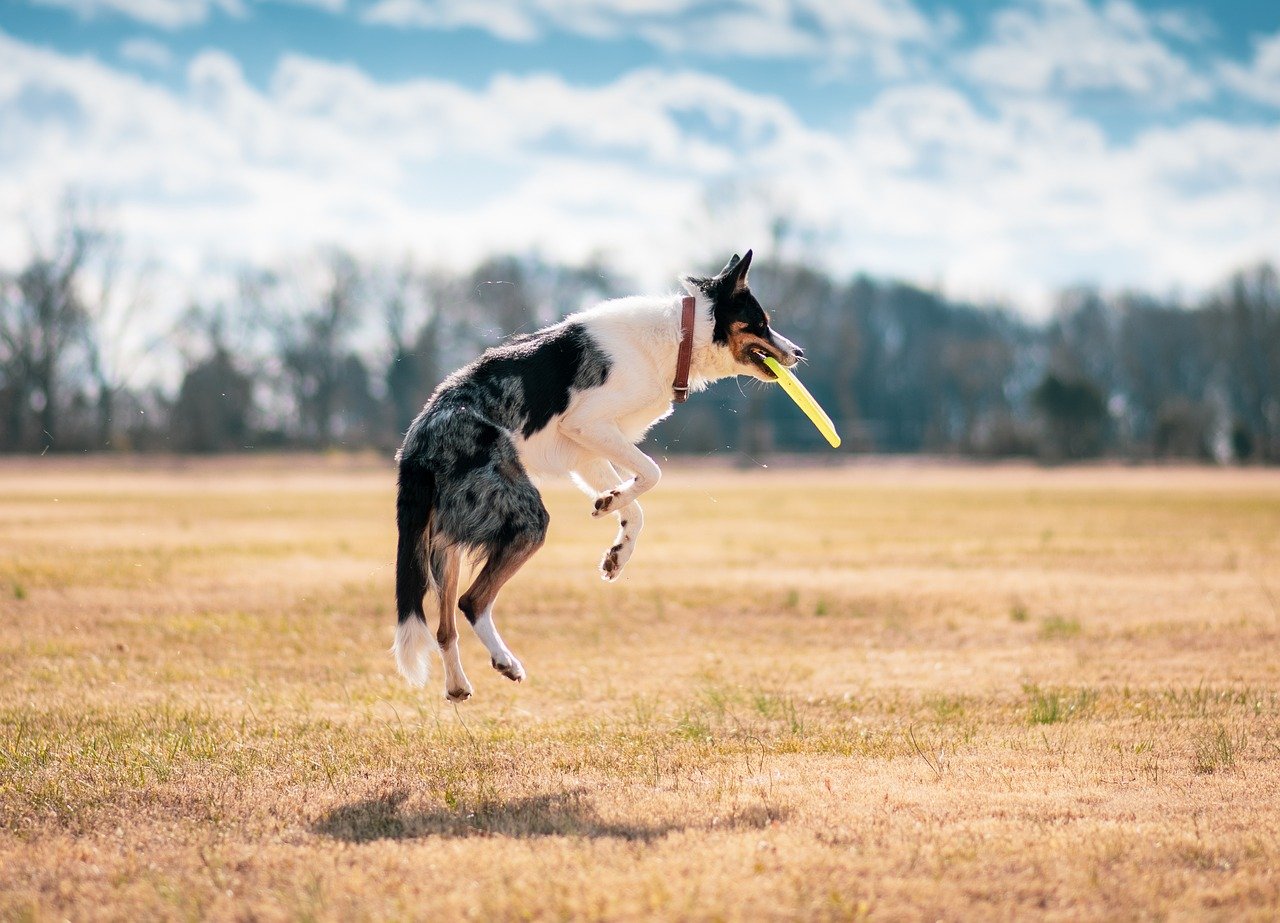
Dealing with Motion Sickness in Pets
Traveling with your furry friend can be a delightful experience, but it can also come with its challenges, especially when it comes to motion sickness. Just like some humans, pets can feel queasy during car rides, which can turn an otherwise fun trip into a stressful ordeal. So, how can you help your pet enjoy the journey without the discomfort of nausea? Let’s dive into understanding motion sickness in pets and explore effective strategies to tackle this issue.
First off, it’s important to recognize the signs of motion sickness in your pet. Some common symptoms include:
- Excessive drooling
- Vomiting
- Restlessness or anxiety
- Panting
- Whining or barking
If you notice any of these signs during your travels, it’s essential to act quickly and address the situation to ensure your pet’s comfort. Ignoring these symptoms can lead to a more complicated journey and may even discourage you from traveling with your pet in the future.
Now, let’s talk about some preventative measures you can take to help reduce the likelihood of motion sickness. One effective approach is to gradually acclimate your pet to car rides. Start with short trips around the block, gradually increasing the distance as your pet becomes more comfortable. This way, your pet can associate the car with positive experiences rather than just long, uncomfortable journeys. Additionally, consider these tips:
- Feed your pet a light meal a few hours before traveling to avoid an upset stomach.
- Keep the car well-ventilated and at a comfortable temperature to minimize discomfort.
- Use calming aids such as pheromone sprays or anxiety wraps to help soothe your pet.
- Consult your veterinarian about medications that can help prevent motion sickness if your pet is particularly prone to it.
Another effective strategy is to create a cozy space for your pet in the car. A familiar blanket or toy can provide comfort and reduce anxiety. If your pet is in a carrier, make sure it’s secured properly, as this can help them feel more stable and less anxious. Remember, a relaxed pet is less likely to experience motion sickness!
In conclusion, while dealing with motion sickness in pets can be a challenge, it’s certainly manageable with the right approach. By recognizing the signs, implementing preventative measures, and creating a comfortable travel environment, you can help your furry friend enjoy the ride as much as you do. After all, the journey is just as important as the destination!
Here are some common questions pet owners have regarding motion sickness:
| Question | Answer |
|---|---|
| Can all pets get motion sickness? | Yes, while it’s more common in dogs and cats, any pet can experience motion sickness. |
| Is there a specific age when pets are more prone to motion sickness? | Young pets may be more susceptible as they are still getting used to car rides. |
| How can I tell if my pet is just anxious or actually motion sick? | Look for symptoms like drooling or vomiting specifically during car rides, which indicate motion sickness. |
| Are there any natural remedies for motion sickness? | Some pet owners find ginger or calming herbs helpful, but consult your vet before trying anything new. |
Signs of Motion Sickness
Traveling with pets can be an exhilarating experience, but it can also come with its challenges, especially when it comes to motion sickness. Just like humans, our furry friends can feel queasy during car rides, and recognizing the signs early can make all the difference. So, what should you be on the lookout for?
First and foremost, excessive drooling is often one of the most noticeable signs. If you see your pet drooling more than usual, it could be a telltale sign that they’re feeling uneasy. Another common indicator is vomiting. While it’s not pleasant to think about, if your pet starts to vomit, it’s a clear signal that they’re struggling with motion sickness.
Additionally, keep an eye out for restlessness. If your pet is pacing back and forth, whining, or trying to escape their seat, they may be feeling anxious or uncomfortable. In some cases, you might even notice them panting heavily or exhibiting signs of distress, such as wide eyes or a tucked tail. These behaviors can indicate that your pet is not enjoying the ride and may be experiencing nausea.
In more severe cases, pets may also display loss of appetite or even lethargy after a trip. If your pet seems unusually tired or disinterested in their usual activities following a car ride, it could be a sign that they experienced discomfort during travel. It’s essential to monitor your pet closely and take action if you notice these signs.
To summarize, here are some key signs of motion sickness to watch for:
- Excessive drooling
- Vomiting
- Restlessness or anxiety
- Panting heavily
- Loss of appetite
- Lethargy
By being vigilant and attentive to these signs, you can help ensure your pet has a more comfortable journey. If you notice any of these symptoms, it may be wise to pull over, give your pet a break, and assess their condition. Remember, a little extra care can go a long way in making travel enjoyable for both you and your furry companion!
Q: Can all pets experience motion sickness?
A: Yes, while not all pets suffer from motion sickness, many do, especially young animals or those not used to traveling. It's essential to be aware of your pet's individual reactions to car rides.
Q: What can I do if my pet shows signs of motion sickness?
A: If your pet shows signs of motion sickness, consider taking frequent breaks, providing fresh air, and consulting your veterinarian for possible medications or remedies that can help alleviate their discomfort.
Q: Are there specific breeds that are more prone to motion sickness?
A: While any pet can experience motion sickness, some breeds, particularly those with shorter snouts like Bulldogs and Pugs, may be more susceptible due to their anatomy and respiratory issues.
Q: How can I prevent motion sickness in my pet?
A: Gradually acclimating your pet to car rides, ensuring they travel on an empty stomach, and using calming products or medications recommended by your veterinarian can help reduce the likelihood of motion sickness.
Preventative Measures for Motion Sickness
Motion sickness can be a real bummer when traveling with your furry friend. Just imagine your pet, usually full of energy and excitement, feeling queasy in the car. It's heartbreaking, right? Thankfully, there are several preventative measures you can take to help minimize the risk of motion sickness and ensure a smooth ride for both you and your pet.
First and foremost, consider training your pet to get accustomed to car rides. Start with short trips around the block, gradually increasing the distance as your pet becomes more comfortable. This gradual exposure can help desensitize them to the movement of the vehicle. Just like humans, pets can adapt to new experiences, so be patient and encouraging during this process.
Another crucial factor is timing their meals. It's best to avoid feeding your pet a large meal right before hitting the road. Instead, try to feed them a few hours in advance. A light snack can also be beneficial, but keep it small to prevent any potential upset stomach. You wouldn't want to eat a huge meal before a roller coaster ride, would you?
Additionally, keep your pet's environment calm during the trip. Create a cozy space in the car with their favorite blanket or toy. This familiar scent can provide comfort and help reduce anxiety. If your pet is particularly nervous, consider using a calming spray or a natural remedy like CBD oil, but always consult with your vet before trying new products.
If your pet has a history of severe motion sickness, it might be worth discussing medication options with your veterinarian. There are several anti-nausea medications designed specifically for pets that can make a significant difference during travel. Your vet can help determine the right option based on your pet's health and travel plans.
Lastly, always monitor your pet closely during the journey. Look for any signs of discomfort, such as drooling, whining, or restlessness. If you notice any of these symptoms, it's essential to pull over safely and give your pet a break. This not only helps them feel better but also allows you to check in and provide reassurance.
By taking these preventative measures, you can help ensure that your pet enjoys the ride just as much as you do. Remember, a little preparation goes a long way in making travel a positive experience for both you and your furry companion!
- What should I do if my pet gets motion sickness during the trip? If your pet shows signs of motion sickness, pull over safely, allow them to get some fresh air, and give them time to settle down. You can also offer water or a light snack if they're up for it.
- Can I use human medications for my pet's motion sickness? No, never give your pet human medications without consulting your veterinarian, as some can be harmful to animals.
- How can I tell if my pet is prone to motion sickness? If your pet has shown signs of nausea, drooling, or vomiting during previous car rides, they may be prone to motion sickness. It's best to take preventative measures before your next trip.

Traveling with Pets: Legal Considerations
When you embark on a road trip with your furry friend, it's not just about packing their favorite toys and snacks; you also need to navigate the maze of legal considerations that come with traveling with pets. Understanding the regulations in different states can save you from unnecessary headaches and ensure a smooth journey. Did you know that some states have specific laws regarding pet travel? For instance, certain areas may require pets to be restrained during transit, while others may have health certification requirements for pets crossing state lines.
Before you hit the road, it's crucial to familiarize yourself with the pet travel regulations in each state you plan to visit. These regulations can vary widely, and ignorance is not an excuse if you find yourself in a sticky situation. Here’s a quick overview of some common legal requirements:
| State | Regulation |
|---|---|
| California | Pets must be restrained in a carrier or with a seatbelt. |
| Florida | No specific pet travel laws, but pets must be kept under control. |
| New York | Pets should be secured while the vehicle is in motion. |
| Texas | No specific laws, but it's recommended to use pet restraints. |
In addition to state regulations, you also need to think about your pet's identification. It's vital to ensure your pet is easily identifiable in case they get lost during your travels. Microchipping is a great option, as it provides a permanent form of identification. Alongside microchipping, always carry a collar with an ID tag that includes your contact information. This simple step can be a lifesaver if your pet goes missing.
Moreover, some states or regions may have specific health requirements for pets, such as proof of vaccinations or health certificates, especially if you’re traveling with pets across state lines. This is particularly important for dogs, as certain states may require proof of rabies vaccination. Always check the regulations for the states you will be visiting to ensure you have the necessary documentation.
Finally, it’s also a good idea to keep a copy of your pet’s medical records handy. This includes vaccination records and any medications your pet may need. If an emergency arises while you're on the road, having this information readily available can make a world of difference. So, before you set off on your adventure, take the time to do your homework on the legalities of pet travel. It’s not just about being a responsible pet owner; it’s about ensuring a safe and enjoyable experience for both you and your furry companion.
- What should I do if my pet gets lost while traveling? Make sure your pet is microchipped and has an ID tag with your contact information. If they go missing, immediately check local shelters and post on social media.
- Are there any states that do not allow pets in vehicles? No state outright bans pets in vehicles, but some have regulations about how pets must be restrained while driving.
- Do I need a health certificate for my pet when traveling? It depends on the state you are traveling to. Some states require health certificates, especially for dogs, so check the specific requirements.
Pet Travel Regulations by State
When it comes to traveling with your furry friends, understanding pet travel regulations is essential. Each state has its own set of rules that can affect how you transport your pet. Ignoring these regulations can lead to fines or, worse, complications during your journey. So, before you embark on your adventure, it's crucial to be aware of the specific laws in the states you plan to visit.
For instance, some states require pets to be restrained in a specific manner while others have regulations regarding vaccination records. It's not just about keeping your pet safe; it's about being a responsible pet owner. To give you a clearer picture, here’s a brief overview of some common regulations:
| State | Regulation |
|---|---|
| California | Pets must be restrained while in a vehicle. |
| New York | Dogs must be secured in a carrier or with a seatbelt. |
| Florida | Pets should have current rabies vaccinations. |
| Texas | No specific pet travel laws, but restraint is recommended. |
In addition to state regulations, some cities may have their own rules regarding pets in public spaces, especially in areas like parks or public transport. Always check local laws to avoid any surprises. Furthermore, consider that if you’re traveling across state lines, you might need to provide proof of vaccinations or health certificates, particularly for dogs and cats. This is especially important if you plan to stay at hotels or campgrounds that have specific pet policies.
Lastly, remember that being proactive can save you a lot of trouble. Carry a copy of your pet's vaccination records, microchip information, and any necessary health documents. This not only ensures compliance with regulations but also provides peace of mind during your travels.
- What should I do if my pet gets lost while traveling? Make sure your pet has a microchip and a collar with identification tags. If they go missing, contact local shelters and use social media to spread the word.
- Are there any specific vaccinations required for traveling with pets? It varies by state, but common requirements include rabies vaccinations. Always check specific state laws before you travel.
- Can I take my pet on public transportation? Many public transport systems have rules about pets. Some allow them if they're in carriers, while others may have restrictions. Be sure to check the policy of the transport service you plan to use.
Pet Identification and Microchipping
When embarking on a road trip with your furry friend, one of the most critical aspects to consider is pet identification. Imagine this: you stop for a quick break, and in the blink of an eye, your pet darts off, chasing after a squirrel or a butterfly. Panic sets in, and you realize that without proper identification, your chances of finding them again diminish significantly. This is where microchipping comes into play.
Microchipping is a simple, safe, and effective way to ensure that your pet can be identified if they get lost. A microchip is a tiny device, about the size of a grain of rice, that is implanted under your pet's skin, usually between the shoulder blades. This chip contains a unique identification number that links to your contact information in a database. If someone finds your lost pet and takes them to a vet or animal shelter, they can scan the chip and retrieve your details, allowing for a swift reunion.
While microchipping is a fantastic safety measure, it’s also essential to ensure that your pet wears a collar with an ID tag, especially during travel. The tag should include your pet’s name, your phone number, and any other relevant information. This way, if your pet gets lost, there’s a higher chance that someone will be able to contact you quickly. It's worth noting that both microchips and ID tags are necessary; they serve as complementary measures rather than substitutes for one another.
| Identification Method | Benefits | Considerations |
|---|---|---|
| Microchipping | Permanent, unique ID; can’t be lost or removed | Requires a vet visit for implantation; must keep contact info updated |
| ID Tag | Visible; easy for finders to contact you | Can be lost or removed; may wear out over time |
Before you hit the road, make sure to check that your pet's microchip is registered and that your contact information is current. You can usually do this through the microchip company’s website or by calling their customer service. If you’ve moved or changed your phone number, don’t forget to update your details!
Finally, it's essential to remember that while microchipping and ID tags are crucial for identification, they are not foolproof. Always keep a close eye on your pet, especially in unfamiliar environments. A little caution can go a long way in ensuring that your adventure together remains a happy one.
- How does microchipping work? Microchipping involves implanting a tiny chip under your pet's skin, which contains a unique ID number linked to your contact information.
- Is microchipping safe? Yes, microchipping is a safe procedure performed by veterinarians. It is similar to a routine vaccination.
- Do I need to update my pet's microchip information? Yes, it’s crucial to keep your contact information up to date to ensure you can be reached if your pet is found.
- Can my pet be identified without a microchip? Yes, a collar with an ID tag can help identify your pet, but it’s more vulnerable to being lost than a microchip.
Frequently Asked Questions
- How can I prepare my pet for a long car trip?
Start by getting your pet used to the car. Take them on short rides to help them acclimate. Make sure they have a comfortable space in the car, with familiar items like their favorite blanket or toy. Gradually increase the duration of the trips to build their confidence.
- What essential travel gear do I need for my pet?
Invest in a good quality pet carrier or harness, depending on your pet's size and comfort. You should also have a leash, water bowl, and some snacks handy. Don’t forget to pack any medications your pet might need during the trip!
- How do I choose the right carrier for my pet?
When selecting a carrier, consider your pet's size and temperament. It should be spacious enough for them to stand, turn around, and lie down comfortably. Look for a sturdy design with good ventilation and secure latches to ensure safety.
- Can I use a regular seat belt for my pet?
While you can use a regular seat belt, it’s best to invest in a seat belt harness specifically designed for pets. These harnesses attach to the seat belt and keep your pet secure, reducing the risk of injury during sudden stops or accidents.
- What should I do if my pet gets motion sickness?
If your pet shows signs of motion sickness, try to keep their head still and avoid sudden movements. You can also consult with your vet about medications or natural remedies. Additionally, feeding them a light meal a few hours before travel may help.
- How often should I take breaks during long trips?
It’s recommended to take breaks every 2 to 3 hours. This gives your pet a chance to stretch their legs, relieve themselves, and stay hydrated. Use these breaks to offer them some playtime or a quick walk to keep their spirits high!
- What are the legal considerations for traveling with pets?
Legal requirements can vary by state, so it’s important to research the regulations in the areas you’ll be traveling through. This may include leash laws, pet travel restrictions, or quarantine rules. Always ensure your pet has proper identification, like a collar tag or microchip.
- Should I microchip my pet before traveling?
Yes! Microchipping is a great way to ensure your pet can be identified if they get lost. Make sure your contact information is up to date in the microchip registry. Additionally, having a collar with an ID tag is a good backup plan.

